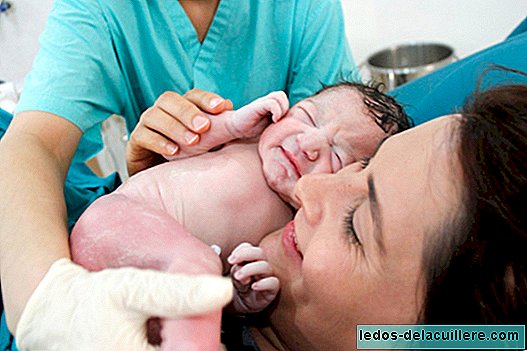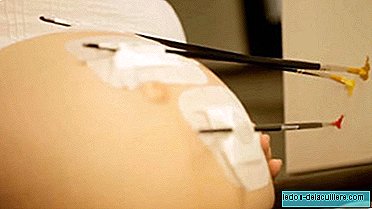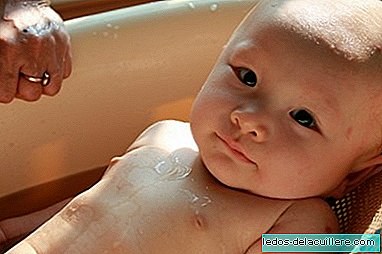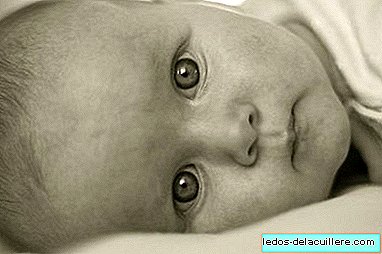A few months ago we talked about a curious and innovative research related to the bacteria with which a baby is contaminated at birth. Apparently, for a baby it is not the same to give birth vaginally as by caesarean section, because the intestinal flora that is acquired is very different in both situations.
In the investigation of which I spoke to you, we considered the possibility of helping babies born by caesarean section to have a microbiota similar to those born through vaginal delivery with a simple practice: pass a gauze stuck in the mother's vagina on the baby's face, so that it could help the baby's immune system.
Given the increase in demand for this practice in hospitals, some professionals have refused to do so, arguing that it is not proven to be useful and that the baby is put at risk of unwanted infections: "I'm sorry, but I won't pass the chiffon from your vagina through your baby's face".
It could be dangerous for babies
As we read in Voice Populi, the researcher Aubrey Cunnington published in the British Medical Journal an editorial with the intention of raising awareness among parents and healthcare professionals (the measure has become very popular in the United Kingdom and the US) that it is a practice whose effectiveness is not yet proven and that poses a danger to the baby .
The demand for this procedure has increased among women who go to hospitals in the United Kingdom, but this has exceeded the surveillance and knowledge of professionals. At the moment we are far from having evidence to recommend this practice. There is simply no evidence to suggest its benefits and it could carry potential risks.
When talking about the risks, it means that through the gauze in the mother's vagina, some bacteria or viruses are transmitted to the baby causing an unwanted infection. The most dangerous microorganism is type B streptococcus, which It is also dangerous in cases of vaginal delivery, and for which women are screened in Spain before delivery in case they may need antibiotic treatment.
According to Cunnington, if a woman had the bacteria, she should receive the same prophylactic treatment despite giving birth by caesarean section and the doctors in charge of the baby should be informed that this maneuver has been carried out, so that the baby is treated in the same way than babies born vaginally.
And in some countries, such as the United Kingdom, The test is not done to see if the woman has streptococcus Present in your vagina.
But it does not only refer to this bacterium, it also speaks of gonorrhea, chlamydia or herpes, diseases that can be transferred through gauze:
A colleague had to intervene when a mother with genital herpes, who had undergone caesarean section, was about to start the procedure. Cleaning the baby with gauze could have transferred herpes virus.
The benefit of doing so is also not clear.
As I explained in the other article, the researchers saw that the babies who had had this practice managed to have an intestinal, anal and skin microbiota, very similar to that of babies born vaginally.
However, they added that it is not yet clear the long-term health consequences that this method could cause, by not being quantified what would be the benefit of restoring bacteria who do not receive at birth by caesarean section.
Faced with this doubt, Cunnington warns in his article that with this practice they are doing something with potential risks without a proven benefit. Also, consider the following:
Trying to breastfeed and avoid unnecessary antibiotics may be more relevant to bacteria in the baby's intestine than worrying about transferring vaginal fluid through gauze.
And then what is better?

It's the million dollar question, but it's very difficult to answer because, as the researchers say, It is not yet known what is the benefit of doing so. It is known that babies born by caesarean section who pass vaginal gauze do manage to have an intestinal flora similar to that of children born vaginally, but the benefit is not quantified.
If it were known that this clearly decreases the risk of allergies or immune diseases it could be said that it is better to do it than not to do it: then the culture should be done to know if the woman has streptococcus B in the vagina and, in that case, administer antibiotic prior to caesarean section and to the introduction of the gauze in the woman's vagina. Also, avoid carrying out the practice in case the woman has any of the diseases mentioned, if the infection cannot be prevented in any way (if a woman has genital herpes does not mean that those who do not have it should not do so).
If, on the other hand, it was known that the benefit is very low compared to the risk then one thing should be weighed against the other, that is, assess the risk-benefit of the practice and act accordingly.
In the meantime, I would not be as blunt as Cunnington: if the mother is informed of the risks and possible benefits and if the tests show that there is no risk of vaginal transmission of any serious illness, why not offer the baby the opportunity to born by caesarean section as if she had had a vaginal birth?
For the rest, I completely agree with what he says: breastfeeding and avoiding antibiotics have been seen to be two factors that have a lot to do with the baby's flora.
Photos | iStock
In Babies and more | That a newborn is contaminated by his mother seems to be the most advisable, The way of birth determines the first bacteria that the baby harbors, would you choose to give birth by caesarean section if you could?












